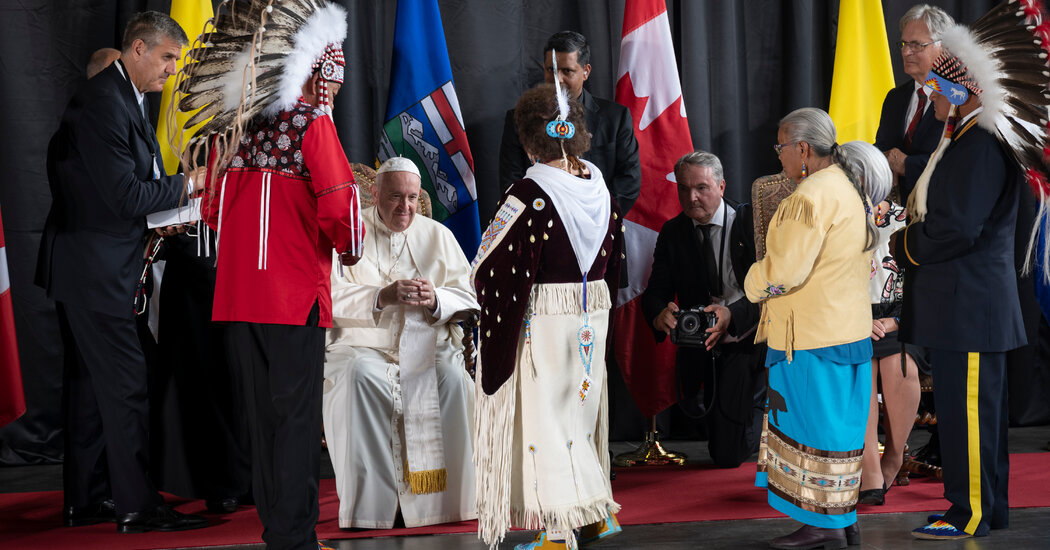
TORONTO — The last church-run residential schools in Canada that Indigenous children were forced to attend, and where many were abused, closed in the 1990s. Since then, the Canadian government and Indigenous communities have worked to address the profound damage inflicted there, which continues to reverberate today.
Here are five important moments leading to the apology Pope Francis is to deliver to Indigenous communities on Monday.
A brutal system of abuse in the name of assimilation.
The Indian Act of 1876 allowed the Canadian government to establish the residential schools, most of which were operated by the Roman Catholic Church and were meant to assimilate Indigenous children by erasing their culture and languages.
They were punished for speaking Indigenous languages, wearing their hair in braids or practicing religion outside of what was being taught at school.
Over more than a century, roughly 150,000 students attended some 130 schools, where many were sexually abused, malnourished and fell sick from the poor conditions. Many died or never returned home.
As the number of students dwindled, the last of the schools closed in 1996, ushering in a period of national reckoning, including official investigations, over Canada’s treatment of Indigenous people.
A major class action settlement for former students.
As a result of a lawsuit by former students at the schools, Canadian courts approved a sweeping class-action settlement that has paid out more than 3.2 billion Canadian dollars to about 28,000 survivors, according to a 2021 report by an independent committee overseeing the settlement.
In addition to financial compensation, the settlement also included funding for other initiatives, such as memorials and other commemorative projects and a program that provides mental health services to survivors and their families.
A national commission leads to a reckoning with a grim past.
A National Truth and Reconciliation Commission created in 2007 as part of the settlement agreement hosted gatherings in seven cities across the country to, among other things, hear the firsthand accounts of Indigenous people who had been sent to residential schools.
At local hearings, survivors shared their stories of Catholic monks raping children younger than 10 and hungry students resorting to stealing apples from orchards to eat.
In 2008, Prime Minister Stephen Harper issued an official apology from the government to Indigenous communities.
Evidence of unmarked graves discovered at residential schools.
Last year, the Tk’emlups te Secwepemc First Nation in British Columbia said it had found evidence of unmarked graves of 215 children on the grounds of the Kamloops Indian Residential School, which was once the largest in Canada, with about 500 students.
The discovery, made using ground-penetrating radar, shocked Canadians and revived a national discourse around the horrors of residential schools.
Several other communities also announced preliminary findings of possible unmarked graves on former residential school grounds. Last June, Cowessess First Nation said it had found 751 possible unmarked graves at the site of a school in Saskatchewan.
A trip to Italy and a papal apology.
In the spring, a delegation of Indigenous leaders from Canada traveled to the Vatican, and received a hoped-for apology from Pope Francis.
“I feel shame — sorrow and shame — for the role” that Catholics played “in the abuses you suffered and in the lack of respect shown for your identity, your culture and even your spiritual values,” Francis said. He also promised to travel to Canada and deliver a personal apology.
Ian Austen contributed reporting from Ottawa.


More Stories
Elapath Energy’s Ambitious Gas Storage Construction Paves the Way for Renewable Energy Revolution in Singapore
Save Earth Mission: Uniting the World in the Biggest Movement for a Sustainable Future
Lieutenant General Vijay Kumar Singh, the Revered Patriot, to Grace the Spectacular Grand Takeoff Event of Save Earth Mission